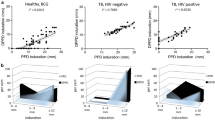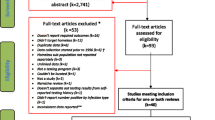Abstract
OBJECTIVE: To define the prevalence of and factors associated with having a negative purified protein derivative (PPD) among persons who self-report a prior positive PPD and to define the safety of repeat testing in such persons.
DESIGN: Observational cohort study.
SETTING: Methadone maintenance program with onsite primary care.
PATIENTS/PARTICIPANTS: Current or former drug users enrolled in methadone maintenance treatment.
INTERVENTIONS: Structured interview, tuberculin skin testing regardless of self-reported PPD status, and anergy testing.
MEASUREMENTS AND MAIN RESULTS: Nearly one third (31%) of participants who self-reported a prior positive PPD had a negative measured PPD, despite receipt of a “booster” PPD. A single participant (0.5%) blistered in response to the PPD without lasting ill effect. Participants with PPD results discordant from their history were more likely to be HIV-seropositive and nonreactive to the anergy panel. The discordance rate among HIV-infected participants was 43%, and was largely attributable to immune dysfunction. Among HIV-seronegative participants, the discordance rate was 27%. Recent crack-cocaine use was independently associated with discordance in the absence of HIV infection.
CONCLUSIONS: We confirmed that planting a PPD in patients who self-report a positive PPD history confers minimal risk. Substantial rates of discordance exist between self-reported history of a positive PPD and measured PPD status. Further research is needed to define the optimal management of PPD-negative patients who self-report a prior positive PPD and who have not received prior treatment for latent tuberculosis.
Similar content being viewed by others
References
Geiter L, ed. Ending Neglect: The Elimination of Tuberculosis in the United States. Washington, DC: National Academy Press; 2000.
Centers for Disease Control and Prevention. Targeted tuberculin testing and treatment of latent tuberculosis. MMWR Recomm Rep. 2000;49:1–51.
Selwyn PA, Hartel D, Lewis VA, et al. A prospective study of the risk of tuberculosis among intravenous drug users with human immunodeficiency virus infection. N Engl J Med. 1989;320:545–50.
Fernandez-Villar A, Sopena B, Vazquez R, et al. Isoniazid hepatoxicity among drug users: the role of hepatitis C. Clin Infect Dis. 2003;36:293–8.
Schoenbaum EE, Hartel D, Selwyn PA. Risk factors for human immunodeficiency virus infection in intravenous drug users. N Engl J Med. 1989;321:874–9.
Ewing JA. Detecting alcoholism: the CAGE questionnaire. JAMA. 1984;252:1905–7.
Sokal JE. Measurement of delayed skin-test response. N Engl J Med. 1975;293:501–2.
Reichman LB, O’Day R. The influence of a history of a previous test on the prevalence and size of reactions to tuberculin. Am Rev Resp Dis. 1977;115:737–41.
Salomon N, Perlman DC, Friedmann P, Ziluck V, Des Jarlais DC. Prevalence and risk factors for positive tuberculin skin tests among active drug users at a syringe exchange program. Int J Tuberc Lung Dis. 2000;4:47–54.
Ferebee SH. Controlled chemoprophylaxis trials in tuberculosis. A general review. Bibl Tuberc. 1970;26:28–106.
Wilson LM. Reversal of the tuberculin reaction: its significant in case finding by survey skin testing. Am Rev Resp Dis. 1970;102:282–4.
Fisk TL, Hon H, Lennox JL, von Reyn CF, Horsbrugh CR. Detection of latent tuberculosis among HIV-infected patients after initiation of highly active antiretroviral therapy (research letter). AIDS. 2003;17:1102–4.
Hsu KH. Tuberculin reaction in children treated with isoniazid. Am J Dis Child. 1983;137:1090–2.
Perez-Stable EJ, Flaherty D, Schecter G, Slutkin G, Hopewell PC. Conversion and reversion of tuberculin reactions in nursing home residents. Am Rev Resp Dis. 1988;137:801–4.
Kunosky S, Katz J. The stability of the tuberculin reaction. Am Rev Tuberc. 1958;78:863–70.
Klein RS, Smith D, Sobel J, Flanigan T, Margolick JB, for the HER Study Group. A prospective study of positive tuberculin reactions in women with or at risk for HIV-1 infection. Int J Tuberc Lung Dis. 2000;4:688–92.
Tager IB, Kalaidjian R, Baldini L, Rocklin RE. Variability in the intradermal and in vitro lymphocyte responses to PPD in patients receiving isoniazid chemoprophylaxis. Am Rev Respir Dis. 1985;131:214–20.
Atuk NO, Hunt EH. Serial tuberculin testing and isoniazid therapy in general hospital employees. JAMA. 1971;218:1795–8.
Wolfe H, Marmor M, Maslansky R, et al. Tuberculosis knowledge among New York City injection drug users. Am J Public Health. 1995;85:985–8.
Stein MD, Maksad J, Clarke J. Hepatitis C disease among injection drug users: knowledge, perceived risk and willingness to receive treatment. Drug Alcohol Depend. 2001;61:211–5.
Straus SM, Rindskopf DM, Deren S, Falkin GP. Concurrence of drug users’ self-report of current HIV status and serotest results. J Acquir Immune Defic Syndr. 2001;27:301–7.
Howard AA, Klein RS, Schoenbaum EE, Gourevitch MN. Crack cocaine use and other risk factors for tuberculin positivity in drug users. Clin Infect Dis. 2002;35:1183–90.
Baldwin BD, Roth MD, Tashkin DP. Acute and chronic effects of cocaine on the immune system and the possible link to AIDS. J Neuroimmunol. 1998;83:133–8.
Redfield RR, Wright DG, Tramont EC. The Walter Reed staging classification for HTLV-III/LAV infection. N Engl J Med. 1986;314:131–2.
Snider DE. The tuberculin skin test. Am Rev Respir Dis. 1982;125:108–18.
Author information
Authors and Affiliations
Corresponding author
Additional information
An earlier version of this paper was presented as an abstract at the Society of General Internal Medicine 26th annual meeting, May 2003.
Dr. Kunins is supported by National Institutes on Drug Abuse grant DA-R25-DA14551. Drs. Klein and Gourevitch were supported in part by National Institutes on Drug Abuse grant RO1-DA09521. Dr. Arnsten was supported by the National Institute on Drug Abuse grant R01-DA11869, and by a Robert Wood Johnson Generalist Physician Faculty Scholar Award. Drs. Arnsten, Gourevitch, and Klein were supported in part by National Institute of Allergy and Infectious Diseases Centers for AIDS research grant AI-051519.
Rights and permissions
About this article
Cite this article
Kunins, H.V., Howard, A.A., Klein, R.S. et al. Validity of a self-reported history of a positive tuberculin skin test. J GEN INTERN MED 19, 1039–1044 (2004). https://doi.org/10.1111/j.1525-1497.2004.30424.x
Issue Date:
DOI: https://doi.org/10.1111/j.1525-1497.2004.30424.x




